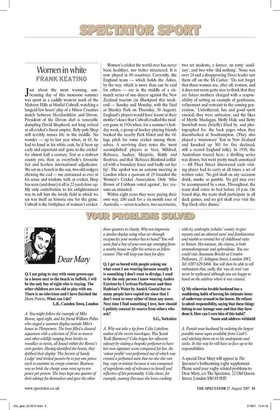Women in white
FRANK KEATING Just about the most warming, sunbeaming day of this monsoon summer was spent in a cuddly western nook of the Malvern Hills at blissful Colwall, watching a languid few hours' play of a Minor Counties match between Herefordshire and Devon. President of the Devon club is venerable dumpling David Shepherd, not long retired as all cricket's finest umpire. Roly-poly Shep still terribly misses life in the middle. No wonder — up to last year when, at 65, he had to hand in his white coat, he'd been up early and expectant and 'gone to the cricket' for almost half a century, first as a stalwart county pro, then as everybody's favourite fair and fearless international adjudicator. We sat on a bench in the sun, two old codgers chewing the cud — me entranced as ever at his sense and wisdom; well, at cricket, Shep has seen (and done) it all in 22-yard close-up. My only contribution to his enlightenment was to tell him the lovely field in which we sat was itself an historic one for the game. Colwall is the birthplace of women's cricket.
Women's cricket the world over has never been healthier, nor better structured. It is now played in 69 countries. Currently, the England team — which holds the Ashes, by the way, which is more than can be said for others — are in the middle of a sixmatch series of one-dayers against the New Zealand tourists (in Blackpool this weekend — Sunday and Monday, with the final at Shenley Park on Thursday, 30 August). England's players would have learnt at their mother's knee that Colwall cradled the modern game in 1926 when, for a summer's holiday week, a group of hockey-playing friends booked the nearby Park Hotel and the village pitch for some cricket among themselves. A surviving diary notes the 'most accomplished' players as Vera, Mildred, Rebecca, Audrey, Marjorie, Biddy and Beatrice, and that 'Rebecca Blaxland collided with a boundary fence and badly cut her lip'. The upshot was an autumn meeting in London when a quorum of 19 founded the Women's Cricket Association. Only 'Miss Brown of Cobham voted against', her reasons un-minuted.
Within eight years they were paying their own way, £80 each for a six-month tour of Australia — seven teachers, two secretaries, two art students, a lawyer, an army 'auxiliary', and two who 'did nothing'. None was over 24 and a disapproving Times leader saw them off on the SS Cathay: 'Do not forget that these women are, after all, women, and it does not seem quite nice to think that they are future mothers charged with a responsibility of setting an example of gentleness, refinement and restraint to the coming generation.' Unbothered, fun and good sport ensued; they were unbeaten, and the likes of Myrtle Maclagan, Molly Hide and Betty Snowball were (briefly) feted by, and photographed for, the back pages when they disembarked at Southampton. (They also played a 'missionary' Test in New Zealand and knocked up 503 for five declared, still a record England tally). In 1938, the Australians toured here: a thrilling series was drawn, but went pretty much unnoticed — till Fleet Street discovered each visiting player had to carry at all times a set of written rules: 'No girl shall on any occasion drink, smoke or gamble. No girl may ever be accompanied by a man. Throughout, the team shall retire to bed before 10 p.m. On board ship, the team shall participate in all deck games, and no girl shall ever visit the Top Deck after dinner.'









































 Previous page
Previous page